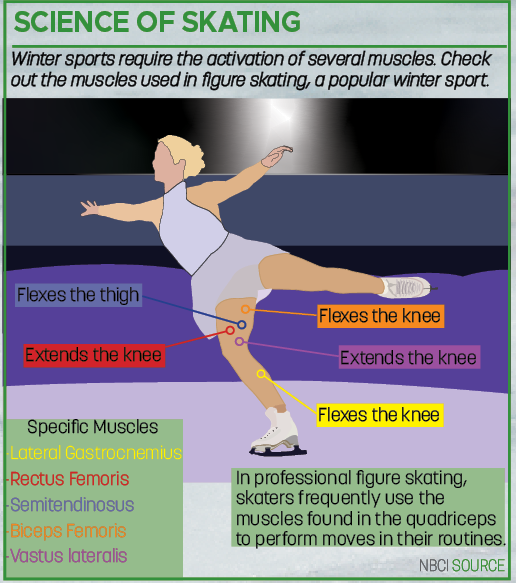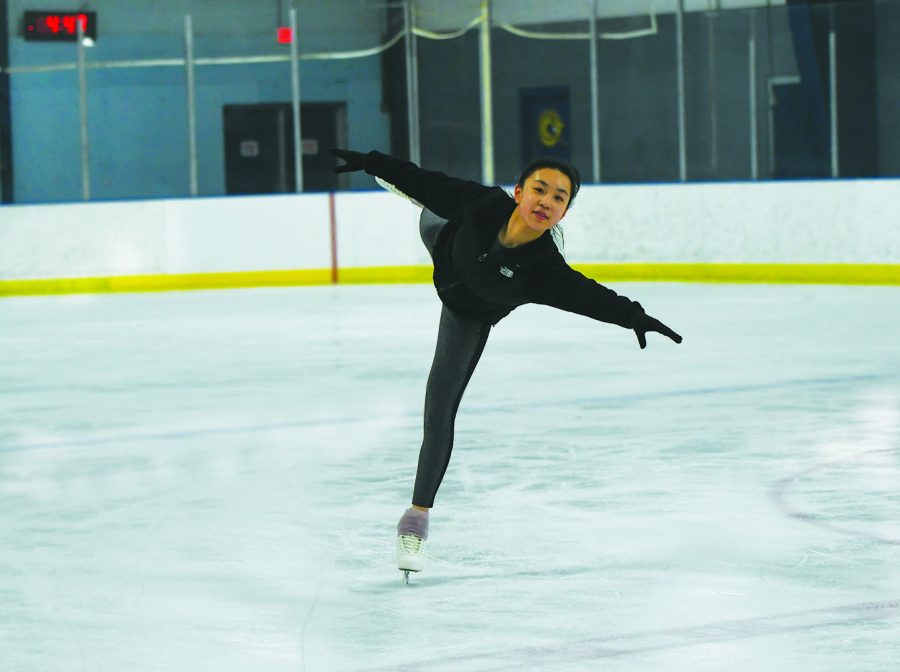Q: Which competitions do you compete in?
A: The Indiana State Championship, the Eastern Great Lakes Regional Championship, and another one is the Battle of the Lakes
Q: How do those competitions work? What must each competitor do?
A: At each competition, there are several events, but the main ones are the short program and the long program. The short program, that’s the one you compete in first, and then, usually, the next day, you’ll compete in the long program, and based off your scores in the two, that’ll determine your placement.
Q: What’s the difference between the short program and the long program?
A: It’s the length of the program itself and the number of elements you have to do. So, for the short program, it depends on the level, but for me, it’s around three minutes and then the long is around four minutes. In the short program, you have certain required elements and there are also less of them, but in the long program, you have a bit more freedom, but you have to complete more elements.
Q: How long have you been figure skating?
A: Since I was eight years old.
Q: What first inspired you to take up figure skating?
A: I went to a birthday party when I was seven or eight, and I really loved it, and I just wanted to come back. I went to a birthday party at the rink.
Q: How do you train for ice skating?
A: So, off ice, I do a lot of training. I’ll do conditioning, which most of it is strength training, so it’s weightlifting. I’ll also do balance exercises and I also do jumping exercises. I’ll work on my rotations, because if I can make the rotations off ice, then I can do it on ice. And then, for on-ice training, I will go through my movements, then my spins, then jumps, and then I’ll also run through my program.
Q: How often do you do on ice training vs. off ice?
A: I’d say each week, I skate more than 10 hours, and then, off ice, I’ll do probably two to three hours a week.

Q: How has this pandemic affected your training for skating?
A: At the rink, one thing that we have to do is we’re required to wear masks when we’re out in the lobby area, but then when we get on the ice, it’s optional. So that can affect your practice if you decide to wear a mask, because it’s a lot harder to breathe. And then for competitions, a lot of them have been canceled, so I haven’t competed in months.
Q: What would you say is the most difficult part of figure skating?
A: I think the most difficult part is consistency. It requires a lot of precision. For example, if your head isn’t in line with your body a certain way, if it’s slightly tilted, then even just something like that can completely throw off your jump, so you need to make sure that when you train, everything is super consistent so once it’s competition day, you know you’ve got it down. So I think consistency is really tricky, because anything that’s small that you do wrong can completely throw you off when you’re skating.
Q: On the other hand, what is your favorite part of figure skating?
A: I think my favorite part of figure skating is the fact that I’m able to express myself when I skate and skating is like an outlet for me. If I have a stressful day, I can step on the ice, and a lot of that stress will go away, because I don’t even think about it when I’m on the ice. And I also just love the community, because I’ve made so many friends through skating and the coaches there are really nice and supportive.
Q: How much has figure skating impacted your daily life?
A: I think figure skating, obviously, it keeps me healthy and energetic, I guess. It’s something to look forward to every day because I pretty much skate everyday. I do devote a lot of time to it, so it’s a big part of my life. It’s just something I really look forward to.
Q: What lessons has figure skating taught you in general?
A: One important lesson is to always get up after you fall. Every time you fall, you get discouraged, and you fall a lot, so just having that motivation every time and that perseverance to get up after every fall is something that is like a skill that has transferred to other areas, so that’s probably one of the most important lessons. Another one would probably be … respect and etiquette, because on the ice, you have to be super respectful of others because there’s normally a lot of people on the ice at once. So, through skating, I’ve learned to be respectful while others are on the ice and respectful to my coaches and my peers. It can get really competitive and sometimes, you’re pitted against each other. At the same time, you have to realize that you’re all working towards your own goals, so you have to be respectful when you’re at the rink.

To view more facts on ice skating, click here: Fun Facts for Kids About Ice Skating (sportsrec.com)
To view another story relating to ice skating and the work put in, click here: HiLite | CHS figure skaters, former U.S. figure skater elaborate on physicality, commitment needed for success in figure skating

































![AI in films like "The Brutalist" is convenient, but shouldn’t take priority [opinion]](https://hilite.org/wp-content/uploads/2025/02/catherine-cover-1200x471.jpg)










































![Review: “The Immortal Soul Salvage Yard:” A criminally underrated poetry collection [MUSE]](https://hilite.org/wp-content/uploads/2025/03/71cju6TvqmL._AC_UF10001000_QL80_.jpg)
![Review: "Dog Man" is Unapologetically Chaotic [MUSE]](https://hilite.org/wp-content/uploads/2025/03/dogman-1200x700.jpg)
![Review: "Ne Zha 2": The WeChat family reunion I didn’t know I needed [MUSE]](https://hilite.org/wp-content/uploads/2025/03/unnamed-4.png)
![Review in Print: Maripaz Villar brings a delightfully unique style to the world of WEBTOON [MUSE]](https://hilite.org/wp-content/uploads/2023/12/maripazcover-1200x960.jpg)
![Review: “The Sword of Kaigen” is a masterpiece [MUSE]](https://hilite.org/wp-content/uploads/2023/11/Screenshot-2023-11-26-201051.png)
![Review: Gateron Oil Kings, great linear switches, okay price [MUSE]](https://hilite.org/wp-content/uploads/2023/11/Screenshot-2023-11-26-200553.png)
![Review: “A Haunting in Venice” is a significant improvement from other Agatha Christie adaptations [MUSE]](https://hilite.org/wp-content/uploads/2023/11/e7ee2938a6d422669771bce6d8088521.jpg)
![Review: A Thanksgiving story from elementary school, still just as interesting [MUSE]](https://hilite.org/wp-content/uploads/2023/11/Screenshot-2023-11-26-195514-987x1200.png)
![Review: "When I Fly Towards You", cute, uplifting youth drama [MUSE]](https://hilite.org/wp-content/uploads/2023/09/When-I-Fly-Towards-You-Chinese-drama.png)
![Postcards from Muse: Hawaii Travel Diary [MUSE]](https://hilite.org/wp-content/uploads/2023/09/My-project-1-1200x1200.jpg)
![Review: "Ladybug & Cat Noir: The Movie," departure from original show [MUSE]](https://hilite.org/wp-content/uploads/2023/09/Ladybug__Cat_Noir_-_The_Movie_poster.jpg)
![Review in Print: "Hidden Love" is the cute, uplifting drama everyone needs [MUSE]](https://hilite.org/wp-content/uploads/2023/09/hiddenlovecover-e1693597208225-1030x1200.png)
![Review in Print: "Heartstopper" is the heartwarming queer romance we all need [MUSE]](https://hilite.org/wp-content/uploads/2023/08/museheartstoppercover-1200x654.png)




